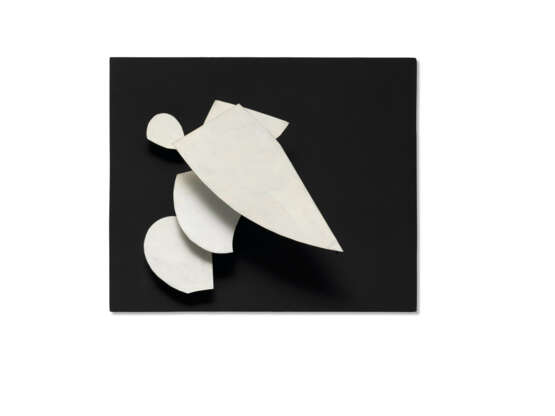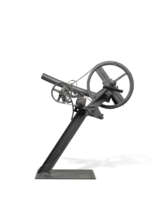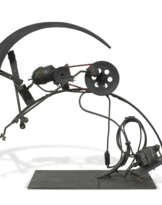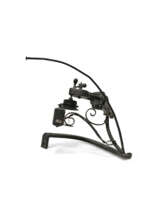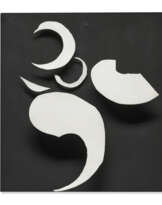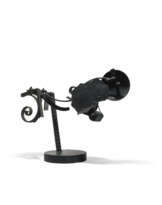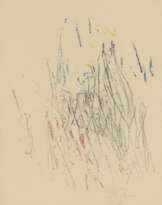ID 832051
Lot 46 | Jean Tinguely (1925-1991)
Estimate value
€ 150 000 – 200 000
Décollage orienté
signé et daté deux fois et inscrit '1957 TINGUELY DÉCOLLAGE ORIENTÉ' (au revers)
cinq éléments métalliques découpés et peints montés sur un panneau de bois peint, poulies en bois, caoutchouc, fixations métalliques, interrupteur et moteur électrique
38 x 46 x 11 cm.
Exécuté en 1957
signed and dated twice and inscribed '1957 TINGUELY DÉCOLLAGE ORIENTÉ' (on the reverse)
five metallic elements cut and painted mounted on a painted wood panel, wood pulleys, rubber belt, metal fixtures, switch and electric motor
15 x 18 1/8 x 4 3/8 in.
Executed in 1957
Provenance
Galerie Bonnier, Genève.
Puis par descendance au propriétaire actuel.
Literature
C. Bischofberger, Jean Tinguely. Catalogue raisonné, Sculptures et Reliefs 1954-1968, Zürich, 1982, vol. 1, no. 133 (illustré p. 107).
Special notice
Artist's Resale Right ("droit de Suite").
If the Artist's Resale Right Regulations 2006 apply to this lot, the buyer also agrees to pay us an amount equal to the resale royalty provided for in those Regulations, and we undertake to the buyer to pay such amount to the artist's collection agent.
ƒ: In addition to the regular Buyer’s premium, a commission of 5.5%
inclusive of VAT of the hammer price will be charged to the buyer.
It will be refunded to the Buyer upon proof of export of the lot
outside the European Union within the legal time limit.
(Please refer to section VAT refunds)
Post lot text
« La vie est mouvement. Tout se transforme sans cesse, et essayer de l'arrêter, essayer d'arrêter la vie en plein vol et de la récupérer sous la forme d'une œuvre d'art, d'une sculpture ou d'une peinture, me semble une moquerie de l'intensité de la vie. Je ne veux que m'impliquer dans l'objet en mouvement qui se transforme sans cesse ». - Jean Tinguely
“Life is movement. Everything is always changing, and trying to stop it, trying to stop life in mid-air and recover it in the form of a work of art, a sculpture or a painting, seems to me a mockery of the intensity of life. I only want to be involved in the object in motion that is constantly transforming itself.” - Jean Tinguely
Artiste d’origine suisse, Jean Tinguely arrive à Paris en 1952 et s'installe impasse Ronsin en 1955. Il rencontre Niki de Saint Phalle l'année suivante, alors que celle-ci se rend avec son mari dans l’atelier du sculpteur pour y acquérir un relief. En 1960, tous deux s'étaient séparés de leurs partenaires et Saint Phalle avait rejoint Tinguely dans son appartement de l’impasse Ronsin.
Née de ce contexte charnière dans la vie de l’artiste, Décollage orienté est une pièce emblématique, qui s’inscrit dans l’évolution de l’œuvre cinétique de Jean Tinguely. Certaines de ses premières sculptures étaient déjà des reliefs en mouvement : dans ses méta-Malevich de 1954-1955, des barres et des disques faisaient écho aux compositions du maître suprématiste, se déplaçant sur diverses orbites et vitesses, créant des ballets aléatoires de formes épurées. Des engrenages asynchrones réglés pour tourner à des vitesses différentes semblaient faire flotter des formes hétérogènes dans l’espace, les configurations de formes ne se répétant qu'à des intervalles aléatoires. Ces œuvres rendaient hommage à la composition pure et géométrique, tout en mettant au centre de la réflexion l’importance du mouvement. Dans cette continuité et contrairement à ce que son titre pourrait laisser entendre, les feuilles de métal légères et organiques de Décollage orienté tournent sans direction cohérente sur un fond noir intense et dramatique. En désorientant l’œil du spectateur, les fragments blancs et délicats qui paraissent voler dans l'air illustrent la démarche fantaisiste du sculpteur.
Comme Alexander Calder, dont les mobiles se donnent pour ambition d’introduire le mouvement dans la sculpture, Tinguely a cherché à libérer l'art de toute logique qu’il considère rigide. Ce faisant, l’artiste souligne combien le mouvement est l'une des seules certitudes de la vie. Toujours mouvant et changeant dans sa danse lente et hypnotique, Décollage orienté oblige celui qui l’observe à être présent à l’instant de la contemplation ; l’œuvre est une machine lyrique qui célèbre le temps qui passe.
Jean Tinguely, an artist of Swiss origin, arrived in Paris in 1952 and moved to Impasse Ronsin in 1955. He met Niki de Saint Phalle the following year, when she went with her husband to the sculptor's studio to acquire a relief. By 1960, both had separated from their partners and Saint Phalle joined Tinguely in his apartment on the impasse Ronsin.
Born from this pivotal moment in the artist's life, Décollage orienté is an emblematic piece that is part of the evolution of Jean Tinguely's kinetic work. Some of his early sculptures were already moving reliefs: in his meta-Malevich works of 1954-1955, bars and discs echo the compositions of the Suprematist master, moving in various orbits and speeds, creating random ballets of pure forms. Asynchronous gears set to rotate at different speeds seem to float heterogeneous forms in space, with configurations of forms repeating only at random intervals. These works pay homage to pure, geometric composition, while at the same time placing the importance of movement at the center of the reflection. In this continuity, and contrary to what the title might suggest, the light, organic metal sheets of Décollage orienté rotate without coherent direction against an intense, dramatic black background. By disorienting the viewer's eye, the delicate white fragments that appear to fly through the air illustrate the sculptor's whimsical approach.
Like Alexander Calder, whose mobiles set out to introduce movement into sculpture, Tinguely seeks to free art from what he considers rigid logic. In doing so, the artist emphasizes how movement is one of the only certainties of life. Always moving and changing in its slow, hypnotic dance, Décollage orienté forces the observer to be present in the moment of contemplation; the work is a lyrical machine that celebrates the passing of time.
| Artist: | Jean Tinguely (1925 - 1991) |
|---|---|
| Art style: | Post War Art |
| Place of origin: | Western Europe, Europe, Switzerland |
| Auction house category: | Paintings |
| Artist: | Jean Tinguely (1925 - 1991) |
|---|---|
| Art style: | Post War Art |
| Place of origin: | Western Europe, Europe, Switzerland |
| Auction house category: | Paintings |
| Address of auction |
CHRISTIE'S 8 King Street, St. James's SW1Y 6QT London United Kingdom | |
|---|---|---|
| Preview |
| |
| Phone | +44 (0)20 7839 9060 | |
| Buyer Premium | see on Website | |
| Conditions of purchase | Conditions of purchase |



